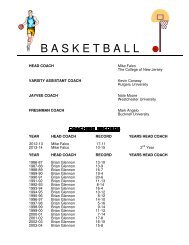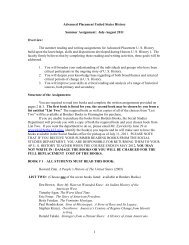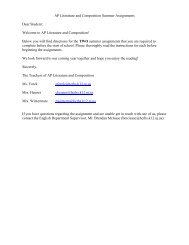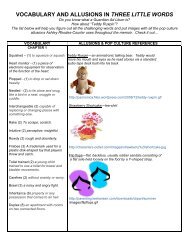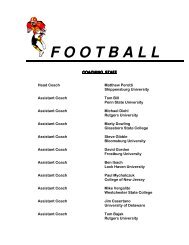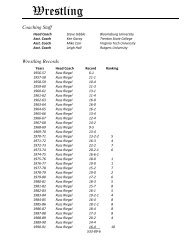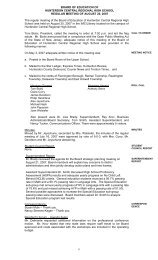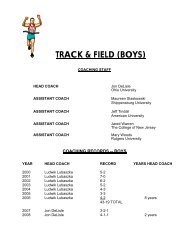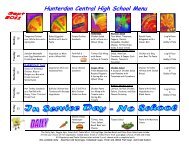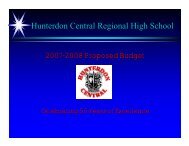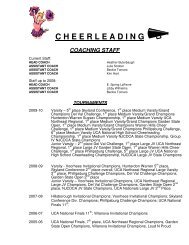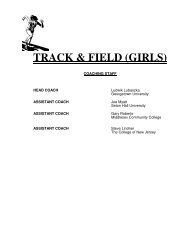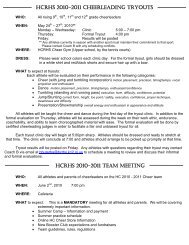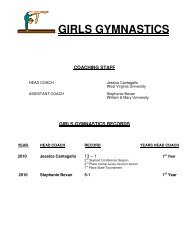HUNTERDON CENTRAL REGIONAL HIGH SCHOOL DISTRICT
HUNTERDON CENTRAL REGIONAL HIGH SCHOOL DISTRICT
HUNTERDON CENTRAL REGIONAL HIGH SCHOOL DISTRICT
You also want an ePaper? Increase the reach of your titles
YUMPU automatically turns print PDFs into web optimized ePapers that Google loves.
Project-Based Learning: "I “taught” a unit (Nuclear Chemistry) entirely by utilizing Project-Based Learning.<br />
Overall, as far as the students and their learning, interest and motivation go, again, I don't think this made a<br />
difference one way or the other. The final project grades were similar to regular grades. However, part of the<br />
project grade was a quiz. The students performed more poorly on this quiz compared to how they usually<br />
perform on tests for units that I teach in a traditional way. If anything, though, the project was something<br />
different for the students. Also, part of the project grade was a family presentation. I received nothing but<br />
positive feedback from the parents.”<br />
Mrs. Sharon Cooper shares the following:<br />
“I incorporated an inquiry-based set of activities during the nomenclature unit. Students were placed in groups<br />
and were given a set of examples to examine. They had to look for patterns and come up with a set of rules for<br />
naming. I incorporated some of the chemquests as an introduction to concepts. I do believe all this did help the<br />
students become better problem solvers. I do plan on doing more of this next year in all my classes to raise the<br />
level of thinking.”<br />
Mr. Walt Schulwitz has this to share:<br />
“In the Introduction to Forensic Science course, the students end the year in a three-day laboratory crime scene<br />
project of solving a kidnapping case using the skills, experiments, and data sheets from the previous seven units.<br />
They end up working in an investigatory group of five or six students to test and analyze several items of<br />
evidence. Their conclusion will be to select the guilty party or parties.”<br />
The integration of technology was through the use of the digital camera in ANATOMY & PHYSIOLOGY.<br />
Here the student was able to take pictures through the microscope at slides they prepared, which ended up on<br />
the classes’ presentations for all to see. Also, to help alleviate the stress of not being an artist, the students were<br />
permitted to take pictures of their dissections. That particular lab group (or individual) was able to use this<br />
printed photo for labeling the parts assigned in that particular system.”<br />
Mr. Jay Kreisman shares the following:<br />
“The Aviation Science elective focused many of the class activities around projects that were planned and<br />
completed by the students. These were all student-based activities that included students teaching navigation to<br />
other students, demonstrating how parachutes and paper airplanes work, and building life-sized helicopter and<br />
fixed wing aircraft control panels with controls and instrumentation.<br />
Some CP Chemistry classes used a project-based learning activity on nanotechnology and its applied use. This<br />
was a multi-lab project that spanned about a week.”<br />
Inquiry lessons continue to be used on an increased basis. Examples of these lessons are found across all<br />
curricula with samples such as the use of M&M’s to study probability, isotopes, and atomic mass, Alka-Seltzer<br />
rockets to study velocity, acceleration, and Newton’s Laws, and toys to study physical applications. Internetbased<br />
activities and simulations were successfully infused into many of the courses offered.<br />
Many of our Chemistry experiments were also redesigned this year to allow for more inquiry and real world<br />
applications. These changes were made in both introductory and more advanced experiments. A joint research<br />
project with Stevens Institute, in which the students worked on hydrogel applications to be used in the<br />
production of replacement body parts, such as knee and hip replacements, continued this year. The program<br />
took place over a seven-day period in which the students were totally immersed in the investigation and<br />
reporting of results. These results will be shared with Stevens at a later date and improvements and revisions to<br />
the program will be made.<br />
101



